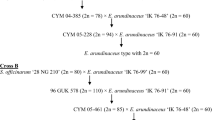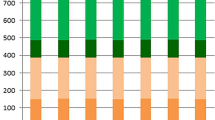Abstract
Triploid onion, Allium × cornutum Clementi ex Visiani, 1842 (2n = 3x = 24), a vegetatively reproduced garden crop, possess a complex triparental genome organization with three putative parental species, A. cepa L., A. pskemense B. Fedtsch., and A. roylei Stearn. Two of its most studied clones are the Croatian ‘Ljutika’ and the Indian ‘Pran’, which are genetically highly similar. Earlier studies have shown that ‘Pran’ possesses some molecular markers in the chloroplast DNA (cpDNA) identical to those of the unique male-sterile (S) cytoplasm, used for onion breeding. To find out whether ‘Ljutika’ also possesses a S-type of cytoplasm, we analyzed several cpDNA and mitochondrial (mtDNA) molecular markers. The PCR amplification and RFLP analysis of the chloroplast genes accD, atpF, petB and the mitochondrial gene cob, as well as the sequence analysis of the chloroplast matK and atpB-rbcL regions showed that ‘Ljutika’ possesses the male-sterile S-type of cytoplasm. The phylogenetic analysis of the matK and atpB-rbcL sequences of A. × cornutum, its parental species and other Allium species of the section Cepa showed that none of the analyzed species had the identical type of cpDNA as A. × cornutum. Results also suggested that A. pskemense can be excluded as a donor of the S-cytoplasm and a female parent, whereas cpDNA of A. roylei, although not identical to S-cytoplasm, possessed many polymorphisms of S-type. Fluorescent in situ hybridization, using fluorescently labelled parental genomic DNAs as probes in combination with fluorescently labelled 5S and 35S rDNAs enabled simultaneous visualization of the three genomes during meiosis and confirmed their homeologus intergenomic pairing.




Similar content being viewed by others
References
Akaike H (1974) A new look at the statistical model identification. IEEE Trans Autom Control 19:716–723
Berninger E (1965) Contribution a l’etude de la sterilite male de l’oignon (Allium cepa L.). Ann Amelior Plant 15:183–199
Cho KS, Yang TJ, Hong SY, Kwon YS, Woo JG, Park HG (2006) Determination of cytoplasmic male sterile factors in onion plants (Allium cepa L.) using PCR-RFLP and SNP markers. Mol Cells 21(3):411–417
Engelke T, Terefe D, Tatlioglu T (2003) A PCR-based marker system monitoring CMS-(S), CMS-(T) and (N)-cytoplasm in the onion (Allium cepa L.). Theor Appl Genet 107:162–167
Fonseca JP, Levy A, Henriques R, Costa JC, Neto C, Robalo J (2016) Phylogenenetic approach of the section D.C. of based on cpDNA. A case of taxonomic inflation? Plant Biosyst Int J Deal Asp Plant Biol 150(4):787–798
Fredotović Ž, Šamanić I, Weiss-Schneeweiss H, Kamenjarin J, Jang TS, Puizina J (2014) Triparental origin of triploid onion, Allium × cornutum (Clementi ex Visiani, 1842), as evidenced by molecular, phylogenetic and cytogenetic analysis. BMC Plant Biol 14:24
Friesen N, Klaas M (1998) Origin of some minor vegetatively propagated Allium crops studied with RAPD and GISH. Genet Resour Crop Evol 45:511–523
Gurushidze M, Mashayekhi S, Blattner FR, Friesen N, Fritsch RM (2007) Phylogenetic relationship of wild and cultivated species of Allium section Cepa inferred by nuclear rDNA ITS sequence analysis. Plant Syst Evol 269:259–269
Hall TA (1999) BioEdit: a user friendly biological sequence alignment editor and analysis program for Windows 95/98/NT. Nucleic Acids Symp Ser 41:95–98
Havey MJ (1991) Phylogenic relationships among cultivated Allium species from restriction enzyme analysis of the chloroplast genome. Theor Appl Genet 81:752–757
Havey MJ (1992) Restriction enzyme analysis of the nuclear 45 s ribosomal DNA of six cultivated Alliums (Alliaceae). Plant Syst Evol 181:45–55
Havey MJ (1993) A putative donor of S-cytoplasm and its distribution among open-pollinated populations of onion. Theor Appl Genet 86:128–134
Havey MJ (1995) Identification of cytoplasm using the polymerase chain reaction to aid in the extraction of maintainer lines from open-pollinated populations of onion. Theor Appl Genet 90(2):263–268
Havey MJ (1999) Seed yield, floral morphology, and lack of male-fertility restoration of male-sterile onion (Allium cepa) populations possessing the cytoplasm of Allium galanthum. J Am Soc Hortic Sci 124(6):626–629
Higgins DG, Thompson JD, Gibson TJ (1996) Using CLUSTAL for multiple sequence alignments. Methods Enzymol 266:383–402
Jones H, Clarke A (1943) Inheritance of male sterility in the onion and the production of hybrid seed. Proc Am Soc Hortic Sci 43:189–194
Jones H, Emsweller SL (1936) A male-sterile onion. Proc Am Soc Hortic Sci 34:582–585
Khar A, Saini N (2016) Limitations of PCR-based molecular markers to identify male-sterile and maintainer plants from Indian onion (Allium cepa L.) populations. Plant Breed 135:519–524
Kim S, Lee E, Cho DY, Han T, Bang H, Patil BS (2009) Identification of a novel chimeric gene, orf725, and its use in development of a molecular marker for distinguishing three cytoplasm types in onion (Allium cepa L.). Theor Appl Genet 118:433–441
Kim S, Park JY, Yang T (2015) Comparative analysis of the complete chloroplast genome sequences of a normal male-fertile cytoplasm and two different cytoplasms conferring cytoplasmic male sterility in onion (Allium cepa L.). J Hortic Sci Biotechnol 90(4):459–468
Klaas M, Friesen N (2001) Molecular markers in Allium. In: Rabinowitch HD, Currah L (eds) Allium crop science: recent advances. CABI Publishing, Wallingford, pp 159–187
Koul AK, Gohil RN (1971) Further studies on natural triploidy in viviparous onions. Cytology 36:253–261
Lepen I, Puizina J (2011) Fish mapping of 18S-5.8S-26S rRNA genes and fluorochrome banding in the triploid viviparous onion Allium × cornutum Clementi ex Visiani, 1842. Acta Biol Crac Ser Bot 53(1):111–116
Lilly JW, Havey MJ (2001) Sequence anaysis of a chloroplast intergenic spacer for phylogenetic estimates in Allium section Cepa and a PCR-based polymorphism detecting mixtures of male-fertile and male-sterile cytoplasmic onion. Theor Appl Genet 102(1):78–82
Maaß HI (1997) Studies on triploid viviparous onions and their origin. Genet Resour Crop Evol 44:95–99
Noguchi J, De-yuan H (2004) Multiple origins of the Japanese nocturnal Hemerocallis citrina var. vespertina (Asparagales: Hemerocallidaceae): evidence from noncoding chloroplast DNA sequences and morphology. Int J Plant Sci 165(1):219–230
Pich U, Fuchs J, Schubert I (1996) How do Alliaceae stabilize their chromosome ends in the absence of TTTAGGG sequences? Chromosome Res 4(3):207–213
Posada D (2008) jModelTest: phylogenetic model averaging. Mol Biol Evol 25:1253–1256
Puizina J (2013) Shallots in Croatia—genetics, morphology and nomenclature. Acta Bot Croat 72:387–398
Puizina J, Papeš D (1996) Cytogenetical evidence for hybrid structure and origin of diploid and triploid shallots (Allium cepa var. viviparum, Lilliaceae) from Dalmatia (Croatia). Plant Syst Evol 199:203–215
Puizina J, Papeš D (1997) Further cytogenetic analyses of the Croatian triploid shallot “Ljutika” (Allium cepa var. viviparum, Alliaceae) and its comparison with the Indian triploid “Pran”. Plant Syst Evol 208:11–23
Puizina J, Javornik B, Bohanec B, Schweizer D, Maluszynska J, Papeš D (1999) Random amplified polymorphic DNA analysis, genome size, and genomic in situ hybridization of triploid viviparous onions. Genome 42:1208–1216
Ronquist F, Huelsenbeck JP (2003) MRBAYES 3: Bayesian phylogenetic inference under mixed models. Bioinformatics 19:1572–1574
Rønsted N, SymondsM RE, Birkholm T, Christensen S, Meerow AW, Molander M, Mølgaard P, Petersen G, Rasmussen N, van Staden J, Stafford GI, Jäger AK (2012) Can phylogeny predict chemical diversity and potential medicinal activity of plants? A case study of Amaryllidaceae. BMC Evol Biol 12(1):182
Saghai Maroof MA, Soliman KM, Jorgensen RA, Allard RW (1984) Ribosomal DNA spacer length polymorphism in barley: Mendelian inheritance, chromosomal location and population dynamics. Proc Natl Acad Sci USA 81:8014–8018
Saini N, Hedau NK, Khar A, Yadav S, Bhatt J, Agrawal PK (2015) Successful deployment of marker assisted selection (MAS) for inbred and hybrid development in long-day onion (Allium cepa L.). Indian J Genet Plant Breed 75(1):93–98
Sato Y (1998) PCR amplification of CMS-specific mitochondrial nucleotide sequences to identify cytoplasmic genotypes of onion (Allium cepa L.). Theor Appl Genet 96:367–370
Senda M, Mikami T, Kinoshita T (1993) The sugar beet mitochondrial gene for the ATP-ase alpha-subunit: sequence, transcription and rearrangements in cytoplasmic male-sterile plants. Curr Genet 24:164–170
Singh F, Ved Brat S, Khoshoo TN (1967) Natural triploidy in viviparous onions. Cytologia 32:403–407
Son JH, Park KC, Park YJ, Kong JH, Kim NS (2010) Sequence diversification of 45S rRNA ITS, trnH-psbA spacer, and matK genic regions in several Allium species. Genes Genomics 32:165–172
Steele PR, Hertweck KL, Mayfield D, McKain MR, Leebens-Mack J, Pires JC (2012) Quality and quantity of data recovered from massively parallel sequencing: examples in Asparagales and Poaceae. Am J Bot 99:330–348
Swofford DL (2001) PAUP*: Phylogenetic analysis using parsimony (*and other methods), Version 4.0b.10 for 32-Bit Microsoft Windows. Sunderland, MA, USA, Sinauer Associates
Tamura K, Peterson D, Peterson N, Stecher G, Nei M, Kumar S (2011) MEGA5: molecular evolutionary genetics analysis using maximum likelihood, evolutionary distance, and maximum parsimony methods. Mol Biol Evol 28:2731–2739
von Kohn C, Kiełkowska A, Havey MJ (2013) Sequencing and annotation of the chloroplast DNAs and identification of polymorphisms distinguishing normal male-fertile and male-sterile cytoplasm of onion. Genome 56:737–742
Vu HQ, Iwata M, Yamauchi N, Shigyo M (2011) Production of novel alloplasmic male sterile lines in Allium cepa harbouring the cytoplasm from Allium roylei. Plant Breed 130(4):469–475
Yamashita K, Tashiro T (1999a) Possibility of developing male sterile line of shallot (Allium cepa L. Aggregatum group) with cytoplasm from A. galanthum Kar. et Mr. I. Japan. Soc Hortic Sci 68:256–262
Yamashita K, Tashiro T (1999b) Possibility of developing male sterile line of shallot (Allium cepa L. Aggregatum group) with cytoplasm from A. galanthum Kar. et Mr. J. Japan. Soc Hortic Sci 68:256–262
Yamashita K, Arita H, Tashiro Y (1999) Cytoplasm of a wild species Allium galanthum Kar. et Kir. is useful for developing male sterile line of A. fistulosum L. J. Japan. Soc Hortic Sci 68:788–797
Acknowledgements
We thank the Centre for Genetic Resources (CGN, Netherlands) for providing specimens of A. pskemense and A. roylei used in this study. This work received funding from the Croatian Ministry of Science, Education and Sport through a grant to Jasna Puizina (No. 177-11911196-0829).
Author’s contribution
The experimental design was conceived by JP. The material was sampled and taxonomically identified by JK. Experiments were performed by ZF, IS, JK. Contributing reagents/consumables/tools by JP. Data were analyzed by JP with assistance from ZF and IS. This paper was written by JP and ZF. All authors read and approved the final manuscript.
Author information
Authors and Affiliations
Corresponding author
Ethics declarations
Conflict of interest
The authors declare that there is no conflict of interest.
Rights and permissions
About this article
Cite this article
Fredotović, Ž., Šamanić, I., Kamenjarin, J. et al. The triparental triploid onion Allium × cornutum Clementi ex Visiani, 1842, possesses a sterile S-type of cytoplasm. Genet Resour Crop Evol 64, 1971–1983 (2017). https://doi.org/10.1007/s10722-017-0489-1
Received:
Accepted:
Published:
Issue Date:
DOI: https://doi.org/10.1007/s10722-017-0489-1




